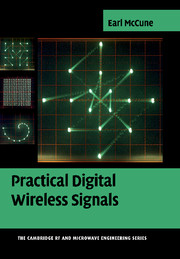Book contents
- Frontmatter
- Contents
- Preface
- Definitions and acronyms
- Terminology and notation
- 1 Keying, states, and block diagram construction
- 2 Common issues and signal characterization
- 3 Important details on results from Shannon, Nyquist, and others
- 4 Digital amplitude modulation (ASK)
- 5 Digital frequency modulation: FSK
- 6 Digital phase modulation: PSK
- 7 Combined digital modulations: QAM and OFDM
- 8 Spread spectrum
- 9 Wireless propagation and antenna fundamentals
- 10 Principles of coding
- 11 Multiple access techniques
- 12 Signal tradeoffs and system evolution
- Tutorial Appendices
- Appendix A Phasor review
- Appendix B Decibels (dB) really are simple
- Appendix C Analog modulation basics
- Appendix D Quadrature modulation and demodulation principles
- Appendix E Polar modulation and demodulation principles
- Appendix F The derivative-zeroed pulse family
- Appendix G Selected DWC standards and their modulations
- Index
Appendix G - Selected DWC standards and their modulations
Published online by Cambridge University Press: 04 August 2010
- Frontmatter
- Contents
- Preface
- Definitions and acronyms
- Terminology and notation
- 1 Keying, states, and block diagram construction
- 2 Common issues and signal characterization
- 3 Important details on results from Shannon, Nyquist, and others
- 4 Digital amplitude modulation (ASK)
- 5 Digital frequency modulation: FSK
- 6 Digital phase modulation: PSK
- 7 Combined digital modulations: QAM and OFDM
- 8 Spread spectrum
- 9 Wireless propagation and antenna fundamentals
- 10 Principles of coding
- 11 Multiple access techniques
- 12 Signal tradeoffs and system evolution
- Tutorial Appendices
- Appendix A Phasor review
- Appendix B Decibels (dB) really are simple
- Appendix C Analog modulation basics
- Appendix D Quadrature modulation and demodulation principles
- Appendix E Polar modulation and demodulation principles
- Appendix F The derivative-zeroed pulse family
- Appendix G Selected DWC standards and their modulations
- Index
Summary
Any discussion on the principles of digital wireless signals must include a presentation on how these principles are used in making signal decisions for actual system design. With a very wide variety of objectives among an even wider variety of applications, it is no surprise that various standards committees have selected widely different DWC signal types.
In the following tables are a collection of modulation choices with an outline of their properties for selected DWC applications. This list is only exemplary and is by no means exhaustive. But the signals represented here do cover the full range of possibilities discussed in Chapter 12.
- Type
- Chapter
- Information
- Practical Digital Wireless Signals , pp. 389 - 400Publisher: Cambridge University PressPrint publication year: 2010

